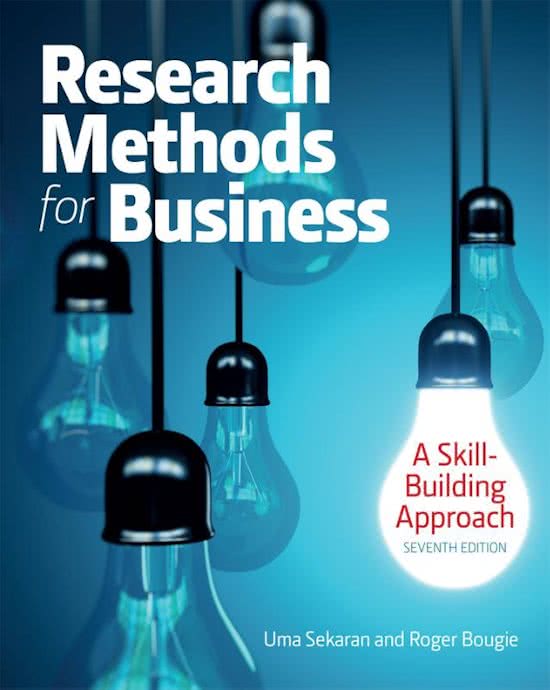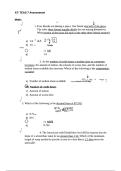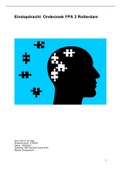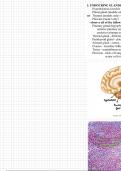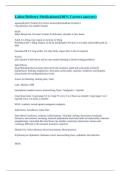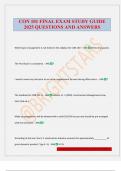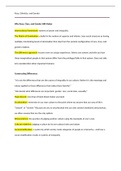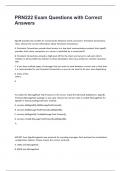Measurement of variables: Operational definition
Learning objectives:
1. Explain how variables are measured
2. Explain when operationalization of variables is necessary
3. Operationally define (or operationalize) abstract and subjective variables
Introduction
Measurement of the variables is an integral part of the research and an important aspect of
research design. Unless the variables are measured in some way, we will not be able to find
answers to our research questions.
How variables are measured
To test the hypothesis that workforce diversity affects organizational effectiveness we have
to measure workforce diversity and organizational effectiveness. Measurement is the
assignment of numbers or other symbols to characteristics of objects according to a
prespecified set of rules. Objects include persons, strategic business units, companies,
countries, bicycles, elephants, kitchen appliances, restaurants, shampoo, yogurt and so on.
Examples of characteristics of objects are the arousal-seeking tendency, achievement
motivation, organizational effectiveness, shopping enjoyment, length, weight, ethnic
diversity, service quality, conditioning effects, and taste. It is important to realize, you cannot
measure objects; you measure characteristics or attributes of objects. In a similar fashion,
you can measure the height of a person, the weight of an elephant, the arousal-seeking
tendency of stockbrokers, etc. To be able to measure you need an object and attributes of
the object, but you also need a judge. A judge is someone who has the necessary
knowledge and skills to assess “the quality” of something, such as the taste of yogurt, the
arousal-seeking tendency of stockbrokers, or the communication skills of a student. In many
cases, the object and the judge are the same people. For instance, if you want to measure
the gender of your employees or the shopping enjoyment of women, you can simply ask the
objects to provide you with the necessary details via a self-administered questionnaire.
, Attributes of objects that can be physically measured by some calibrated instrument pose no
measurement problems. For example, the length and width of a rectangular office desk.
Data representing several demographic characteristics of office personnel are also easily
obtained by asking employees simple, straightforward questions, such as: “How long have
you been working in this organization?” or “What is your marital status?” The measurement
of more abstract and subjective attributes is more difficult. It is relatively difficult to measure
the level of achievement motivation of office clerks, the shopping enjoyment of women, or
the need for the cognition of students. It is not straightforward to test hypotheses on the
relationship between workforce diversity, managerial expertise, and organizational
effectiveness. The problem is that we cannot simply ask questions like “How diverse is your
company’s workforce?” or “How effective is your organization?” because of the abstract
nature of the variables workforce diversity and organizational effectiveness. Certain
variables lend themselves to easy measurement through the use of appropriate measuring
instruments. But when we get into the realm of people’s subjective feelings, attitudes, and
perceptions, the measurement of these factors or variables becomes more difficult.
Accordingly, there are at least two types of variables: one lends itself to objective and
precise measurement: the other is more nebulous and does not lend itself to accurate
measurement because of its abstract and subjective nature.
Operational Definition (Operationalization)
Despite the lack of physical measuring devices to measure the more nebulous variables,
there are ways of tapping these types of variables. One technique is to reduce these
abstract notions or concepts to observable behavior and/or characteristics. For instance, the
concept of thirst is abstract; we cannot see it. However, we would expect a thirsty person to
drink plenty of fluids. If several people say they are thirsty, then we may determine the thirst
level of each of these individuals by the measure of the number of fluids that they drink to
quench their thirst. Reduction of abstract concepts to render them measurable in a tangible
way is called operationalizing the concepts. The first step is to come up with a definition of
the construct that you want to measure. Then, it is necessary to think about the content of
the measure; that is, an instrument that actually measures the concept that one wants to
measure has to be developed. A response format (a seven-point scale with endpoints
anchored by “strongly disagree” and “Strongly agree”) is needed, and finally, the validity and
reliability of the measurement scale have to be assessed.
Operationalization: Dimensions and element
The examples of thirst and need for cognition illustrate how abstract concepts are
operationalized by using observable and measurable elements. You may have noticed that
whereas only one item is needed to measure thirst, 34 items are needed to measure the
need for cognition. These 34 items are needed because if we used fewer than these 34
items, our measurement scale would probably not represent the entire domain or universe of
need for cognition; in other words, our measure would probably not include an adequate and
representative set of items (or elements). As a consequence, our measure would not be
valid. A valid measure of need for cognition thus contains 34 items even though the need for
cognition is a unidimensional construct. An example of a construct with more than one
dimension is aggression. Aggression has at least two dimensions: Verbal aggression and
physical aggression. That is, aggression might include behavior such as shouting and
swearing at a person but also throwing objects, hitting a wall, and physically hurting others.
A valid measurement scale of aggression would have to include items that measure verbal
Learning objectives:
1. Explain how variables are measured
2. Explain when operationalization of variables is necessary
3. Operationally define (or operationalize) abstract and subjective variables
Introduction
Measurement of the variables is an integral part of the research and an important aspect of
research design. Unless the variables are measured in some way, we will not be able to find
answers to our research questions.
How variables are measured
To test the hypothesis that workforce diversity affects organizational effectiveness we have
to measure workforce diversity and organizational effectiveness. Measurement is the
assignment of numbers or other symbols to characteristics of objects according to a
prespecified set of rules. Objects include persons, strategic business units, companies,
countries, bicycles, elephants, kitchen appliances, restaurants, shampoo, yogurt and so on.
Examples of characteristics of objects are the arousal-seeking tendency, achievement
motivation, organizational effectiveness, shopping enjoyment, length, weight, ethnic
diversity, service quality, conditioning effects, and taste. It is important to realize, you cannot
measure objects; you measure characteristics or attributes of objects. In a similar fashion,
you can measure the height of a person, the weight of an elephant, the arousal-seeking
tendency of stockbrokers, etc. To be able to measure you need an object and attributes of
the object, but you also need a judge. A judge is someone who has the necessary
knowledge and skills to assess “the quality” of something, such as the taste of yogurt, the
arousal-seeking tendency of stockbrokers, or the communication skills of a student. In many
cases, the object and the judge are the same people. For instance, if you want to measure
the gender of your employees or the shopping enjoyment of women, you can simply ask the
objects to provide you with the necessary details via a self-administered questionnaire.
, Attributes of objects that can be physically measured by some calibrated instrument pose no
measurement problems. For example, the length and width of a rectangular office desk.
Data representing several demographic characteristics of office personnel are also easily
obtained by asking employees simple, straightforward questions, such as: “How long have
you been working in this organization?” or “What is your marital status?” The measurement
of more abstract and subjective attributes is more difficult. It is relatively difficult to measure
the level of achievement motivation of office clerks, the shopping enjoyment of women, or
the need for the cognition of students. It is not straightforward to test hypotheses on the
relationship between workforce diversity, managerial expertise, and organizational
effectiveness. The problem is that we cannot simply ask questions like “How diverse is your
company’s workforce?” or “How effective is your organization?” because of the abstract
nature of the variables workforce diversity and organizational effectiveness. Certain
variables lend themselves to easy measurement through the use of appropriate measuring
instruments. But when we get into the realm of people’s subjective feelings, attitudes, and
perceptions, the measurement of these factors or variables becomes more difficult.
Accordingly, there are at least two types of variables: one lends itself to objective and
precise measurement: the other is more nebulous and does not lend itself to accurate
measurement because of its abstract and subjective nature.
Operational Definition (Operationalization)
Despite the lack of physical measuring devices to measure the more nebulous variables,
there are ways of tapping these types of variables. One technique is to reduce these
abstract notions or concepts to observable behavior and/or characteristics. For instance, the
concept of thirst is abstract; we cannot see it. However, we would expect a thirsty person to
drink plenty of fluids. If several people say they are thirsty, then we may determine the thirst
level of each of these individuals by the measure of the number of fluids that they drink to
quench their thirst. Reduction of abstract concepts to render them measurable in a tangible
way is called operationalizing the concepts. The first step is to come up with a definition of
the construct that you want to measure. Then, it is necessary to think about the content of
the measure; that is, an instrument that actually measures the concept that one wants to
measure has to be developed. A response format (a seven-point scale with endpoints
anchored by “strongly disagree” and “Strongly agree”) is needed, and finally, the validity and
reliability of the measurement scale have to be assessed.
Operationalization: Dimensions and element
The examples of thirst and need for cognition illustrate how abstract concepts are
operationalized by using observable and measurable elements. You may have noticed that
whereas only one item is needed to measure thirst, 34 items are needed to measure the
need for cognition. These 34 items are needed because if we used fewer than these 34
items, our measurement scale would probably not represent the entire domain or universe of
need for cognition; in other words, our measure would probably not include an adequate and
representative set of items (or elements). As a consequence, our measure would not be
valid. A valid measure of need for cognition thus contains 34 items even though the need for
cognition is a unidimensional construct. An example of a construct with more than one
dimension is aggression. Aggression has at least two dimensions: Verbal aggression and
physical aggression. That is, aggression might include behavior such as shouting and
swearing at a person but also throwing objects, hitting a wall, and physically hurting others.
A valid measurement scale of aggression would have to include items that measure verbal

